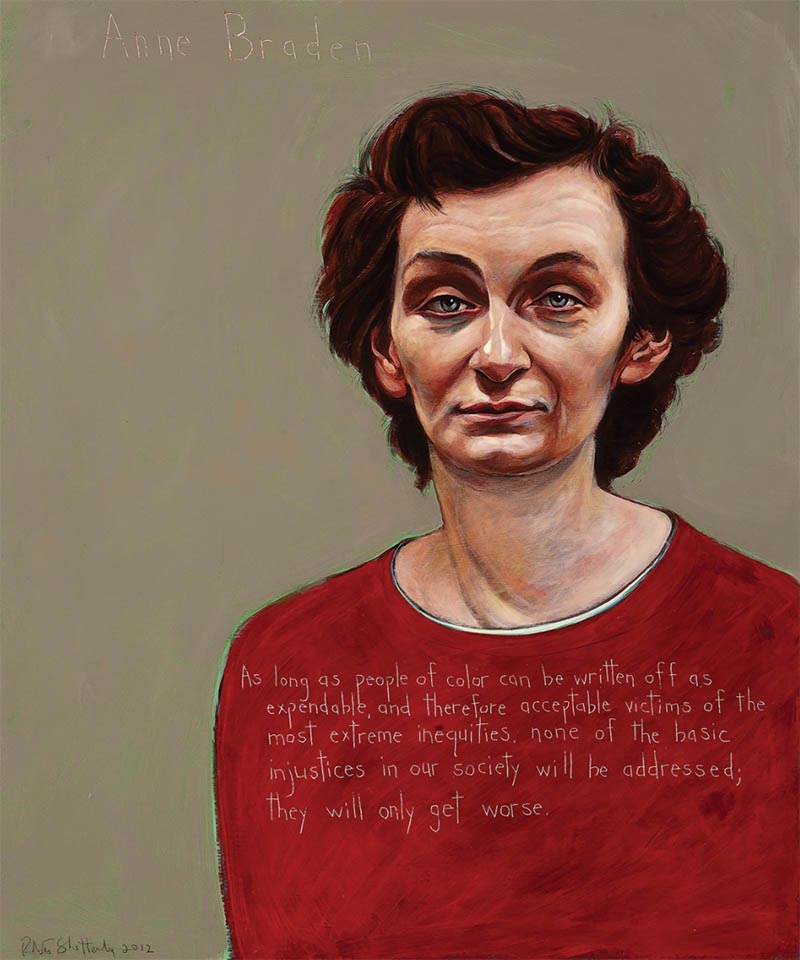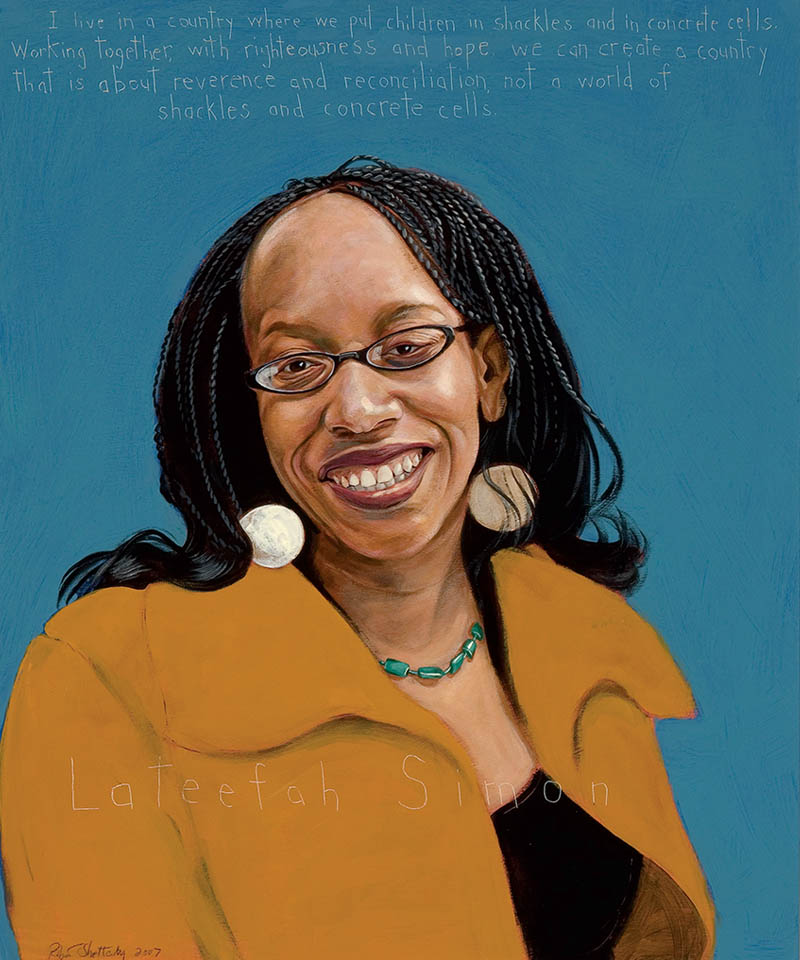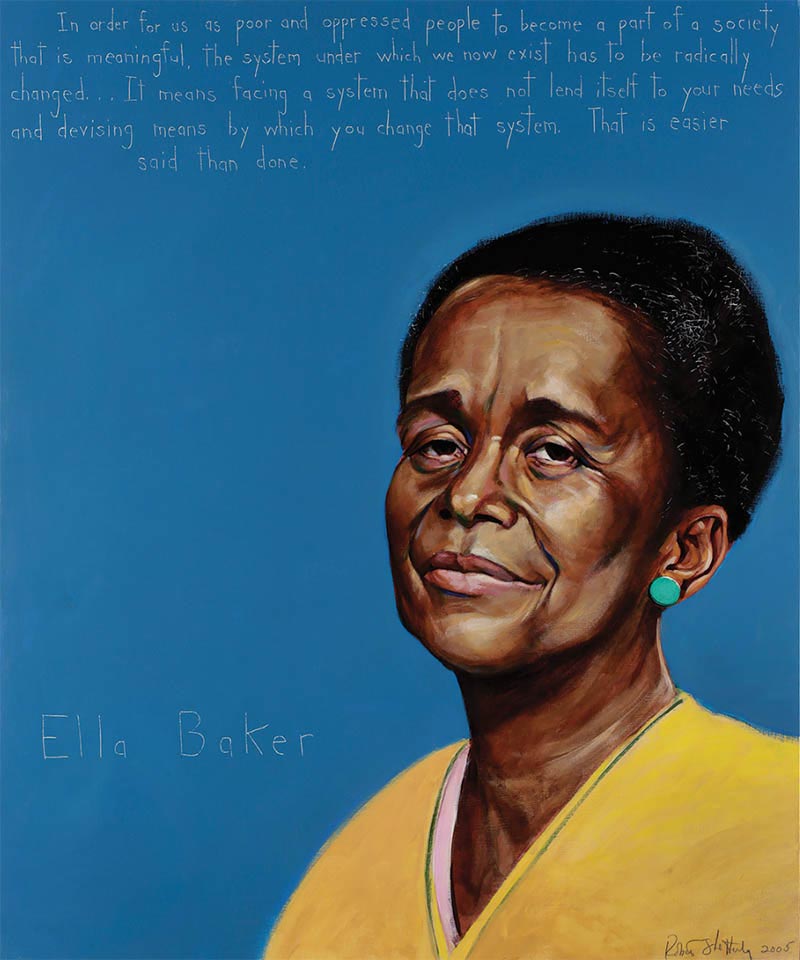What's New
Report from Louisville: August 28-30, 2012
For many years Americans Who Tell the Truth has had a special relationship with the city, the people and the schools of Louisville, Kentucky. The last week of August this year marked one of the highpoints.
On August 30 , The Muhammad Ali Center opened an exhibit of AWTT portraits titled “Muhammad Ali and the Civil Rights Movement.” Forty-two portraits that portray our country’s long struggle for civil rights are hung beautifully in this remarkable space. The portraits on display at the Ali Center include Sojourner Truth, Frederick Douglass, Harriet Tubman, W.E. B. Du Bois, Fannie Lou Hamer, Rosa Parks, Martin Luther King Jr., Malcolm X, William Sloane Coffin, and Louisville’s own, Muhammad Ali and Anne Braden.
The day before the opening at the Ali Center, the recently completed portrait of Anne Braden was unveiled in the rotunda of the Louisville capitol, where Mayor Greg Fischer delivered a moving speech about Anne Braden’s importance to Louisville and to the civil rights movement in the U.S.
Anne Braden, a white woman, was one of the staunchest fighters for civil rights in our history. She was not always honored in Louisville. In the 1950s and 60s many people called her a communist in an attempt to discredit her message of racial equality. One of the great ironies of our history is that those who stood courageously for the values of justice and equality espoused in our Declaration of Independence and Constitution were often demonized and marginalized in an effort to keep racial minorities from enjoying those values.
Mayor Fischer spoke about his dream of having today’s Louisville become a city known for its compassion and dedication to justice. Other speakers included long time friends of Anne Braden – Bob Cunningham, Mattie Jones, and Carla Wallace – who had marched and picketed and strategized with Anne for a better Louisville. Anne’s biographer Cate Fosl, head of the Anne Braden Institute at University of Louisville, gave a talk about Anne’s life. And Anthony Perry, a senior at St. Francis High School, spoke about being inspired by Anne as he has worked to end the school-to-prison pipeline in Louisville. When I spoke, I compared Anne to Rachel Carson. I said that just as Rachel Carson had tried to warn us that chemical pollution was poisoning life on this planet, Anne Braden was trying to warn us that racism was poisoning the soul of our democracy.
Afterward, I was interviewed about the portraits by three young students from the Bloom Elementary School. One of the questions asked me by a young girl named Ella has stuck with me. Ella asked, “What is the hardest thing about telling the truth today in our culture?” I had not been asked this before. I said what’s difficult is this: When we are children, we are counseled by adults to tell the truth. We are told that
adults want to and need to hear the truth, and that becoming a person who always tells the truth is one of the most important characteristics of a good person. A truthful person is trustworthy, a role model; so many good things flow from telling the truth. However, I said, as adults we often discover that adults no longer want to hear the truth – political truth, economic truth, peace truth, environmental truth – if it challenges the status quo, if the truth might upset the ways in which we make money or exploit resources or treat other people. The truth becomes very hard to tell because many adults don’t want to hear it. When we are kids, the truth takes courage to tell when adults demand it. When we are adults the truth takes courage to tell because we want it hidden.
The next day brought a different awareness of young people, adults, and truth. For the fourth time in as many years, I visited Maryhurst, a school and detention center for teenage girls who have been in trouble with the law and are unmanageable in the regular school system. Virtually all of these girls have been abused by the adults in their lives – emotionally, physically, and/or sexually. They have been lied to constantly by adults and, therefore, trust no one. Maryhurst attempts to educate these girls, rebuild there trust by treating them with respect and compassion, introduce structure into their lives, and give them the hope that they can lead productive, responsible lives. I tell them stories of some of the people I’ve painted (Lateefah Simon, LeAlan Jones, Majora Carter, Eve Ensler, John Lewis) who have come from similar backgrounds, turned their lives around, and become leaders fighting for social justice for young people. For several years now, these girls, under the guidance of their art teacher Mari Renn, have been using the model of AWTT to identify, meet and paint the portraits of Louisville citizens they admire. The young women write quotes that inspire them onto the portraits. Their portraits have been shown with mine at the Kentucky Center for African American Heritage in Louisville.
I had lunch with Donald Lassere, the new president of the Muhammad Ali Center. He impressed me greatly with his intelligence, energy and passion for making the Ali Center a world leader in educating young people to build a better world. I am honored that he has chosen AWTT to be one of the first educational partners of his tenure.
The opening events at the Ali Center were spectacular. A large audience of long time civil rights activists, educators, and politicians heard Mayor Fischer speak again about the importance of this exhibit. Donald Lassere spoke about how every person portrayed in the paintings had affected his life. A letter of support from Congressman John Yarmuth, who was unable to attend, was read by his assistant Gil Reyes. And Louisville City Council member Attica Scott praised the work AWTT is doing in the city schools led by AWTT educator Michele Hemenway. Then Carol Kraemer and Cynthia Fletcher led everyone in singing Bernice Johnson Reagon‘s Ella’s Song (in honor of Ella Baker, one of the portraits) which begins:
We who believe in freedom cannot rest
We who believe in freedom cannot rest until it comes…
After the speeches everyone toured the exhibit, and then I was given the opportunity to talk with the audience and answer questions about the portraits and the portrait project. I was pleased to see several students from Central High School (the school Muhammad Ali attended) whom I have gotten to know over the years. They are in the Magnet Law program at Central High that is sponsored by the Brandeis Law School of the University of Louisville. One of the students said that he is so inspired by the portraits that he wants to lead a life that will make me want to paint his portrait.
During both days, Michele Hemenway and I led workshops for elementary, middle and high school teachers about how to incorporate the portrait curriculum into their social studies, literature, science and art classes. These were attended by more than 100 teachers.
These events – the unveiling of Anne Braden’s portrait at the capitol, the exhibit at the Ali Center, and the
use of AWTT in the Louisville public schools – showed us all how deeply this project can influence a
community, give it pride in itself, inspire future action for social justice, and become an important
educational tool.



